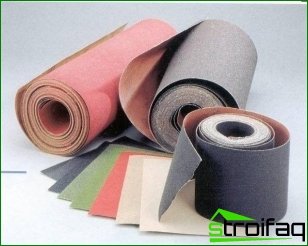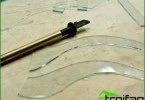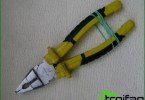Sandpaper is an abrasive material created on a fabric, paper or other basis with a coated layer of abrasive powder. Emery paper or sandpaper is used for manual or machine processing of various surfaces to prepare them for priming, painting, sanding or for removing old paint. As a rule, this material is sold in rolls, but today other tools have been developed using this material, for example, emery sponges.
Sandpaper grain
Granularity is one of the most important characteristics of sandpaper. It displays the number of abrasive particles that occur per inch of material. Therefore, the lower the grain size, the more coarse sandpaper. The modern market of sandpaper offers products with a grain size of 12-4000.
Grain 12-16 means that the sandpaper is very rough. Most often it is used to remove old drying oil or varnish from the floor. Indicator 24-40 also reports that sandpaper is rough, it is used to remove paint from wooden surfaces.
For coarse sanding after removing paint, 60-80 grit paper is used. And sandpaper 80-150 is more gentle. It is used after rough grinding to smooth and level the wooden surface. It is also used for intermediate grinding, removing various imperfections, including marks. Emery paper is called medium.
Fine sandpaper has a grain size of 150-180. With its help, the final grinding of wooden surfaces is carried out before their painting and priming. 200-240 grit material is very thin. Sand paper these numbers are used for intermediate grinding after priming before painting.
The grain size of the extra fine sandpaper is 240-320. With the help of such paper, as a rule, final grinding is performed before painting the wood. Thanks to it, you can accurately remove traces of dust that may appear after painting the surface.
Super thin sandpaper has a grain size of 360-4000. With its help, the final grinding of painted wood is carried out. It allows you to get rid of unnecessary gloss of the glossy surface, as well as the smallest scratches and stains..
Sandpaper is an abrasive material created on a fabric, paper or other basis with a coated layer of abrasive powder. Emery paper or sandpaper is used for manual or machine processing of various surfaces to prepare them for priming, painting, sanding or for removing old paint. As a rule, this material is sold in rolls, but today other tools have been developed using this material, for example, emery sponges.Sandpaper grain
Granularity is one of the most important characteristics of sandpaper. It displays the number of abrasive particles that occur per inch of material. Therefore, the lower the grain size, the more coarse sandpaper. The modern market of sandpaper offers products with a grain size of 12-4000.
Grain 12-16 means that the sandpaper is very rough. Most often it is used to remove old drying oil or varnish from the floor. Indicator 24-40 also reports that sandpaper is rough, it is used to remove paint from wooden surfaces.
For coarse sanding after removing paint, 60-80 grit paper is used. And sandpaper 80-150 is more gentle. It is used after rough grinding to smooth and level the wooden surface. It is also used for intermediate grinding, removing various imperfections, including marks. Emery paper is called medium.
Fine sandpaper has a grain size of 150-180. With its help, the final grinding of wooden surfaces is carried out before their painting and priming. 200-240 grit material is very thin. Sand paper these numbers are used for intermediate grinding after priming before painting.
The grain size of the extra fine sandpaper is 240-320. With the help of such paper, as a rule, final grinding is performed before painting the wood. Thanks to it, you can accurately remove traces of dust that may appear after painting the surface.
Super thin sandpaper has a grain size of 360-4000. With its help, the final grinding of painted wood is carried out. It allows you to get rid of unnecessary gloss of the glossy surface, as well as the smallest scratches and stains..
Sandpaper classification
Most often, sandpaper is classified by type of base. Let’s look at the features of sandpaper on a paper basis. Sandpaper with high density is able to withstand large mechanical stresses. In addition, the base can be ordinary or waterproof.
The advantages of this material include a small cost. In addition, the paper base does not extend its shape, and even the smallest fractions of the grinding material can be applied to its surface. If we talk about the shortcomings, the strength and durability leaves much to be desired..
As a base fabric in sandpaper, cotton or polyester can be used. The fabrics are impregnated with a special resin, which allows them to give additional strength and resistance to moisture. The main features of the fabric base include elasticity and tensile strength.
Sandpaper may have a combined base, which can be obtained by bonding fabric and paper. In stores you can find fiber-based material. But this applies to fiber disks, which are used on an emery machine and allow to process especially hard surfaces..
Abrasive can be applied in different ways.
Emery paper may have a half-open and open filling; moreover, the filling can be closed and solid..
Products with a half-open and open filling differ in that about half of the surface of the base is coated with abrasive grains. With the help of such paper, relatively soft and loose material is processed, which include some wood species. Due to the special surface structure, no lumps form on it, which eliminates clogging of the gaps between grains by grinding waste.
Emery paper with a solid or closed bulk has a base completely coated with abrasive grains. This material is optimal for hard surfaces..
Having understood the types of sandpaper, you could see what material can be used for various purposes..







